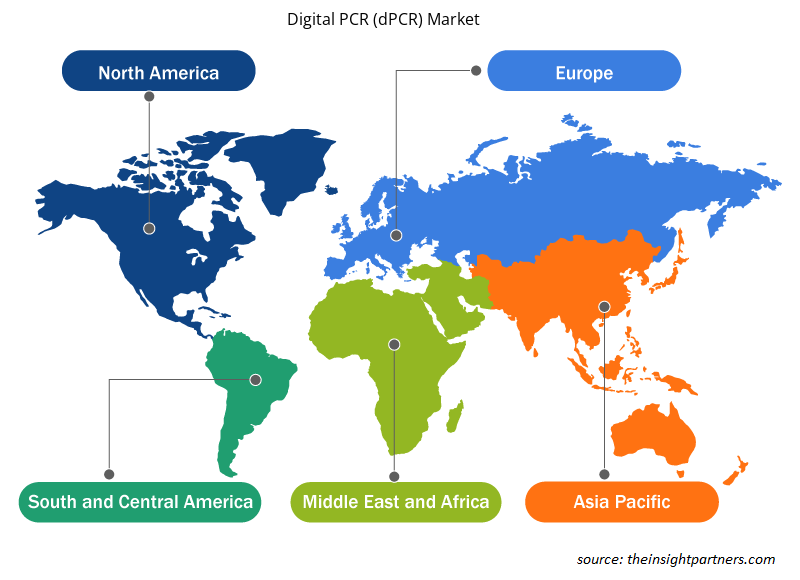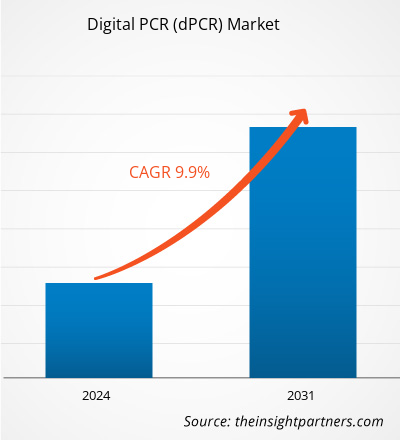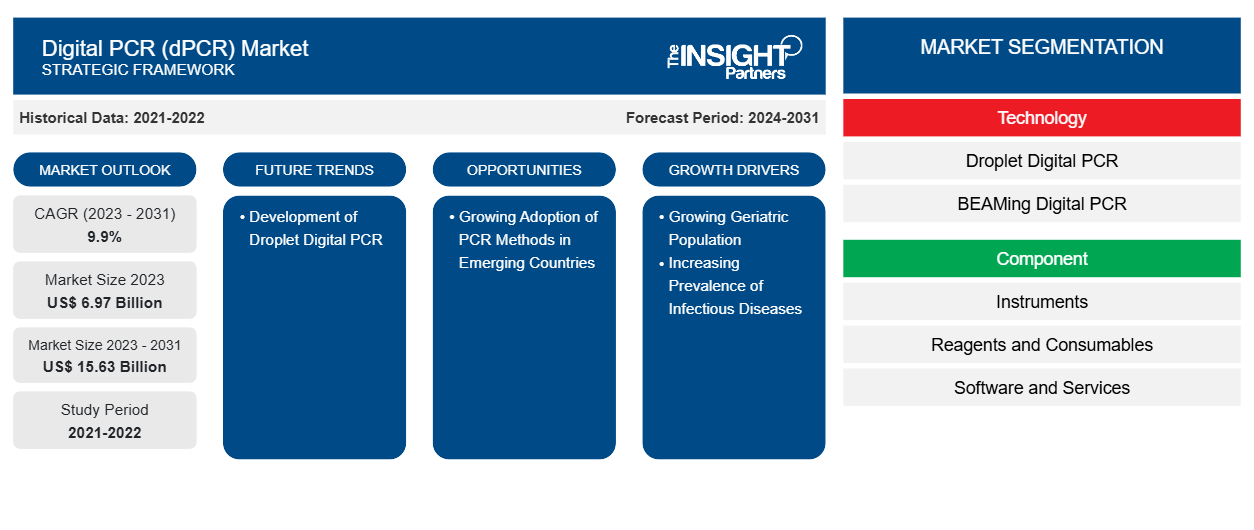Se proyecta que el tamaño del mercado de PCR digital (dPCR) alcance los 15.630 millones de dólares en 2031, desde los 6.970 millones de dólares en 2023; se estima que el mercado registrará una CAGR del 9,9 % durante 2023-2031.
La dPCR es una tecnología innovadora que ofrece cuantificación ultrasensible y absoluta de ácidos nucleicos. Es una de las técnicas más precisas, exactas y sensibles para la detección de secuencias específicas de ácidos nucleicos. Se ha convertido en una herramienta crucial y fiable para el análisis molecular. La creciente incidencia de enfermedades genéticas e infecciosas que pueden diagnosticarse y tratarse mediante técnicas de dPCR respalda el crecimiento del mercado de PCR digital (dPCR) . Las tendencias del mercado de PCR digital (dPCR) incluyen avances tecnológicos que ayudan a la cuantificación absoluta y de alta precisión de las moléculas de ADN objetivo, lo que permite una amplia gama de aplicaciones en el diagnóstico y la investigación.
Factores impulsores del crecimiento:
La síntesis de genes es la herramienta más aceptada en el campo de la tecnología del ADN recombinante. En la síntesis de genes, la expresión de proteínas recombinantes y la tecnología dPCR se utilizan tanto para fines de amplificación como de cuantificación. En 2021, Camena Bioscience, una empresa emergente de biología sintética que suministra genes a las industrias biotecnológica y farmacéutica, completó una ronda de financiación de Serie A de 10 millones de dólares liderada por Mercia. Con los fondos adicionales, la empresa planea expandir sus operaciones e impulsar sus esfuerzos de desarrollo de gSynth, su innovadora plataforma de síntesis de ADN. La plataforma tecnológica y otros recursos relacionados ayudan a la empresa a acelerar el desarrollo de la síntesis de genes.
En 2020, EVONETIX LTD, una startup de biología sintética que crea una plataforma de escritorio para la síntesis genética de alta fidelidad, rápida y escalable, anunció la finalización de su ronda de financiación de Serie B. La empresa, liderada por Foresite Capital (un nuevo inversor), recaudó 30 millones de dólares (23 millones de libras esterlinas) en esta ronda. Por lo tanto, el aumento de las inversiones de las empresas impulsa el crecimiento del mercado de síntesis genética, lo que contribuye al crecimiento del mercado de PCR digital (dPCR).
Personalice este informe según sus necesidades
Obtendrá personalización en cualquier informe, sin cargo, incluidas partes de este informe o análisis a nivel de país, paquete de datos de Excel, así como también grandes ofertas y descuentos para empresas emergentes y universidades.
-
Obtenga las principales tendencias clave del mercado de este informe.Esta muestra GRATUITA incluirá análisis de datos, desde tendencias del mercado hasta estimaciones y pronósticos.
Segmentación y alcance del informe:
El análisis del mercado de PCR digital (dPCR) se ha llevado a cabo considerando los siguientes segmentos: tecnología, componente, aplicación, usuario final y geografía. Según la tecnología, el mercado se segmenta en PCR digital de gotas (ddPCR) y PCR digital BEAMing. En términos de componentes, el mercado se clasifica en instrumentos, reactivos y consumibles, y software y servicios. Según la aplicación, el mercado se clasifica en clínico, de investigación y forense. El alcance geográfico del informe de mercado de PCR digital (dPCR) cubre América del Norte (EE. UU., Canadá y México), Europa (Francia, Alemania, Reino Unido, España, Italia y el resto de Europa), Asia Pacífico (China, Japón, India, Corea del Sur, Australia y el resto de Asia Pacífico), Oriente Medio y África (Arabia Saudita, Sudáfrica, Emiratos Árabes Unidos y el resto de Oriente Medio y África) y América del Sur y Central (Brasil, Argentina y el resto de América del Sur y Central).
Análisis segmental:
El mercado de PCR digital (dPCR), por producto, se clasifica en PCR digital de gotas (ddPCR) y PCR digital BEAMing. El segmento ddPCR tuvo una participación de mercado significativa en 2023. Se prevé que registre la CAGR más alta del mercado durante 2023-2031.
Según los componentes, el mercado se clasifica en instrumentos, reactivos y consumibles, e indicaciones de software y servicios. El segmento de reactivos y consumibles tuvo una participación de mercado significativa en 2023 y se estima que registrará la CAGR más alta durante 2023-2031.
Según la aplicación, el mercado se segmenta en clínico, de investigación y forense. El segmento clínico tuvo una participación significativa en el mercado de PCR digital (dPCR) en 2023; se espera que registre la CAGR más alta durante 2023-2031.
Según el usuario final, el mercado está segmentado en hospitales y centros de diagnóstico, empresas farmacéuticas y biotecnológicas, laboratorios de investigación e institutos académicos, laboratorios forenses y organizaciones de investigación clínica. El segmento de hospitales y centros de diagnóstico tuvo una participación de mercado significativa en la PCR digital (dPCR) en 2023; se espera que registre la CAGR más alta durante 2023-2031.
Análisis regional:
En términos geográficos, el mercado de PCR digital (dPCR) está segmentado en América del Norte, Europa, Asia Pacífico, América del Sur y Central, y Oriente Medio y África. En 2023, América del Norte capturó una parte significativa del mercado. En 2023, Estados Unidos dominó el mercado en esta región. El crecimiento del mercado de PCR digital (dPCR) en América del Norte se atribuye a conferencias científicas, talleres y eventos realizados en Estados Unidos y Canadá, que ayudan a los participantes de diferentes partes del mundo a intercambiar tendencias y los últimos resultados de investigación basados en PCR. Por ejemplo, Global Engage de Global Information Incorporation llevó a cabo una cumbre de dos días en la que se presentaron las contribuciones de científicos de todo el mundo sobre las estrategias y el desarrollo de la dPCR, así como se analizaron estudios de casos que involucran la contribución de la dPCR en la atención médica. La participación activa del país también es uno de los factores impulsores que conducen al crecimiento de la región en el mercado global de PCR digital (dPCR) en la región.
Desarrollos industriales y oportunidades futuras:
El informe de mercado de PCR digital (dPCR) incluye el posicionamiento y la concentración de la empresa para evaluar el desempeño de los competidores en el mercado. Según los comunicados de prensa de la empresa, a continuación se mencionan algunas iniciativas adoptadas por los actores clave que operan en el mercado:
- En julio de 2023, Bio-Rad Laboratories, Inc. lanzó su primer ensayo de dPCR multiplexado ultrasensible: el kit de detección de mutaciones ddPLEX ESR1. Con el lanzamiento de este producto, la empresa planea ampliar la disponibilidad de su oferta de ddPCR para el mercado de la oncología, donde los ensayos de detección de mutaciones multiplexados y altamente sensibles ayudan a la investigación traslacional, la selección de terapias y el seguimiento de enfermedades.
- En junio de 2021, Bio-Rad Laboratories Inc. presentó el “Kit de cuantificación de prevalencia del SARS-CoV-2 en aguas residuales mediante ddPCR”, un instrumento sensible, rentable y preciso para detectar el SARS-CoV-2 en las aguas residuales de la comunidad.
- Los Centros para el Control y la Prevención de Enfermedades (CDC) recomiendan técnicas ddPCR para analizar aguas residuales, y la Agencia de Protección Ambiental (EPA) ha publicado la tecnología como una forma confiable de cuantificar virus en aguas residuales.
Perspectivas regionales del mercado de PCR digital (dPCR)
Los analistas de Insight Partners explicaron en detalle las tendencias y los factores regionales que influyen en el mercado de PCR digital (dPCR) durante el período de pronóstico. Esta sección también analiza los segmentos y la geografía del mercado de PCR digital (dPCR) en América del Norte, Europa, Asia Pacífico, Oriente Medio y África, y América del Sur y Central.

- Obtenga datos regionales específicos para el mercado de PCR digital (dPCR)
Alcance del informe de mercado de PCR digital (dPCR)
| Atributo del informe | Detalles |
|---|---|
| Tamaño del mercado en 2023 | 6,97 mil millones de dólares estadounidenses |
| Tamaño del mercado en 2031 | US$ 15,63 mil millones |
| CAGR global (2023 - 2031) | 9,9% |
| Datos históricos | 2021-2022 |
| Período de pronóstico | 2024-2031 |
| Segmentos cubiertos |
Por tecnología
|
| Regiones y países cubiertos |
América del norte
|
| Líderes del mercado y perfiles de empresas clave |
|
Densidad de actores del mercado de PCR digital (dPCR): comprensión de su impacto en la dinámica empresarial
El mercado de PCR digital (dPCR) está creciendo rápidamente, impulsado por la creciente demanda de los usuarios finales debido a factores como la evolución de las preferencias de los consumidores, los avances tecnológicos y una mayor conciencia de los beneficios del producto. A medida que aumenta la demanda, las empresas amplían sus ofertas, innovan para satisfacer las necesidades de los consumidores y aprovechan las tendencias emergentes, lo que impulsa aún más el crecimiento del mercado.
La densidad de actores del mercado se refiere a la distribución de las empresas o firmas que operan dentro de un mercado o industria en particular. Indica cuántos competidores (actores del mercado) están presentes en un espacio de mercado determinado en relación con su tamaño o valor total de mercado.
Las principales empresas que operan en el mercado de PCR digital (dPCR) son:
- Termo Fisher Scientific, Inc.
- F. Hoffmann-la Roche Ltd.
- QIAGEN
- Biografía de Akara, Inc.
- Tecnologías Agilent, Inc.
Descargo de responsabilidad : Las empresas enumeradas anteriormente no están clasificadas en ningún orden particular.

- Obtenga una descripción general de los principales actores clave del mercado de PCR digital (dPCR)
Panorama competitivo y empresas clave:
El pronóstico del mercado de PCR digital (dPCR) puede ayudar a las partes interesadas a planificar sus estrategias de crecimiento. Thermo Fisher Scientific, Inc.; F. Hoffmann-la Roche Ltd.; QIAGEN; Akara bio, Inc.; Agilent Technologies, Inc.; Biomerieux SA; Abbott Laboratories; Merck KgaA; Promega Corporation; y BD se encuentran entre los actores destacados del mercado. Estas empresas se centran en la introducción de nuevos productos de alta tecnología, avances en productos existentes y expansiones geográficas para satisfacer la creciente demanda de los consumidores en todo el mundo.
- Análisis histórico (2 años), año base, pronóstico (7 años) con CAGR
- Análisis PEST y FODA
- Tamaño del mercado, valor/volumen: global, regional y nacional
- Industria y panorama competitivo
- Conjunto de datos de Excel
Informes recientes
Testimonios
Razón para comprar
- Toma de decisiones informada
- Comprensión de la dinámica del mercado
- Análisis competitivo
- Información sobre clientes
- Pronósticos del mercado
- Mitigación de riesgos
- Planificación estratégica
- Justificación de la inversión
- Identificación de mercados emergentes
- Mejora de las estrategias de marketing
- Impulso de la eficiencia operativa
- Alineación con las tendencias regulatorias























 Obtenga una muestra gratuita para - Mercado de PCR digital (dPCR)
Obtenga una muestra gratuita para - Mercado de PCR digital (dPCR)